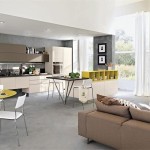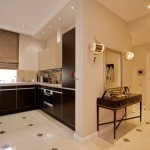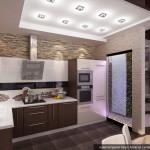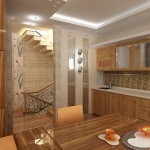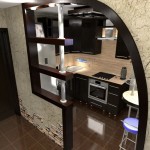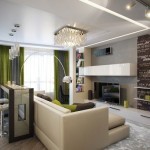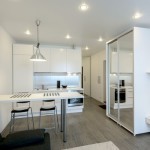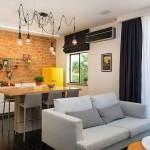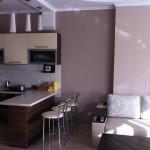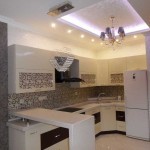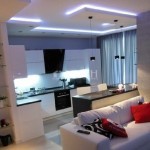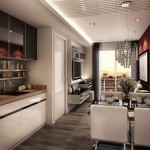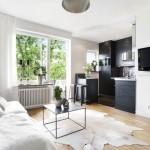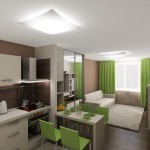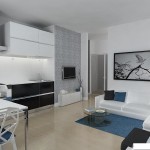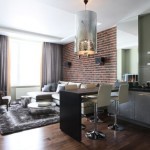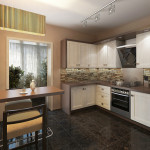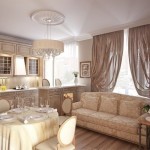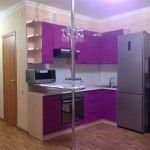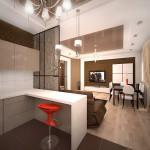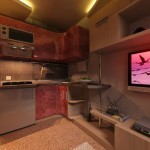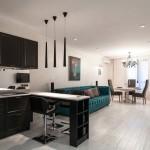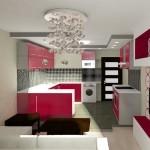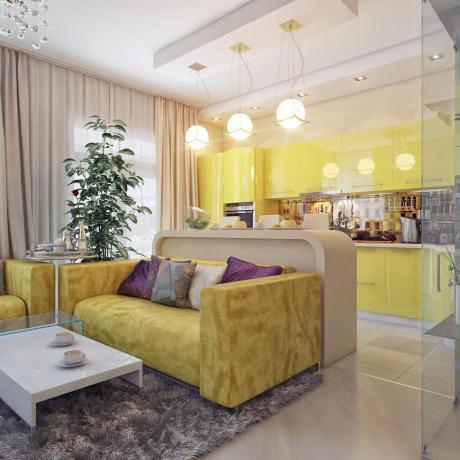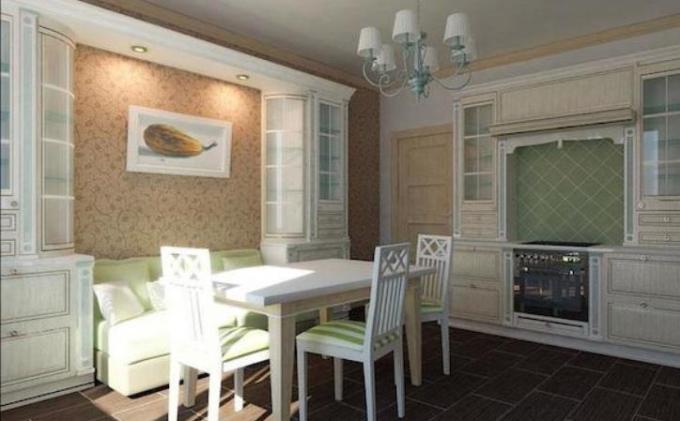Content
- 1 Why is it so important to divide the space into functional zones
-
2 Transitional moments from one zone to another
- 2.1 Floor
- 2.2 Podium
- 2.3 Multilevel ceilings
- 2.4 Other architectural elements
- 2.5 Shine
- 3 Generalization on the topic
Today, many are trying to break existing stereotypes, trying to organize the space so that it helps to live more comfortably, to enjoy all the benefits of civilization.
Therefore, one can often see attempts to combine two adjacent spaces, in which a clear division of the interior into functional areas is read. It is produced in different ways. Most often, for example, you can see the zoning of the kitchen with wallpaper, less often with other structural elements.
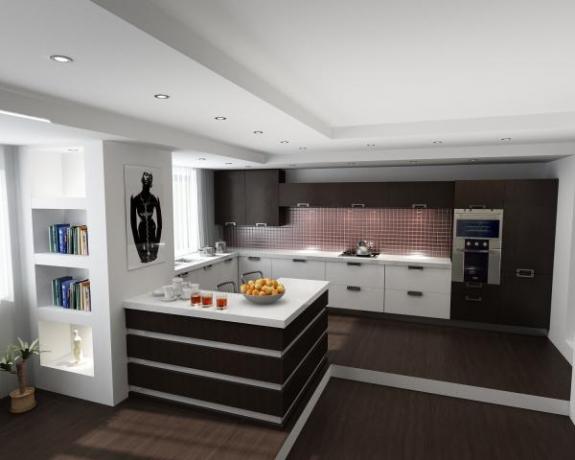
How to highlight functional areas
And what zoning methods generally exist? How can you turn the same kitchen into part of your living space without compromising its main function? There are many receptions. What kind? Let's figure it out.
Why is it so important to divide the space into functional zones
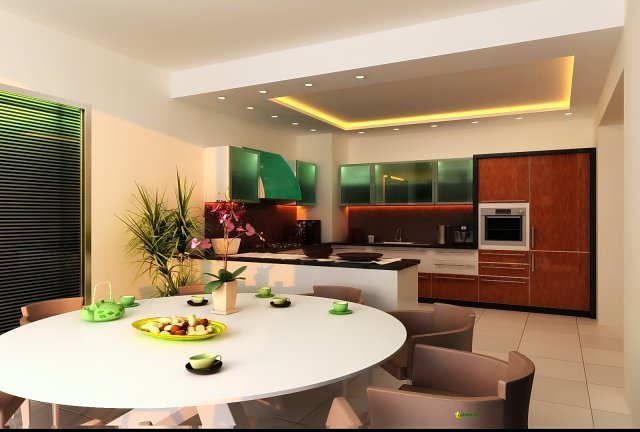
Competent division of functional areas
Experts unanimously argue that one large combined area, in which a clear division into separate sectors, very soon begins to oppress and interfere with the feeling of being the master of one's own apartments.
Why? Yes, because an ordinary person purely psychologically needs hotel zones to perform practical tasks that are different in meaning and content.
- It is important for us not to feel empty space behind our backs when we eat, we need a secluded corner that allows us to retire in order to efficiently complete the task. It is vital for us to have different places that allow us to competently manage the space. Therefore, the place where food is prepared must somehow be separated from where we take it.
- Zoning options are formed taking into account the general stylistic design concept. In any case, it is necessary to ensure that the kitchen does not lose its manufacturability, therefore, certain requirements must be applied to the filling of the interior.
- The work surface is tied to utilities, it needs a wall support, except for the option when part of the kitchen set is transferred to the space under the window. It is necessary to think over the lighting in advance and bring it to all working surfaces.
- The dining area, as a rule, is organized near a source of natural light, away from the place of main activity. Please note that in everything it is necessary to find competent proportions, organize the space so that both the kitchen and the dining area are not damaged, due to the infringement of certain functionality. And yet a more comfortable place is reserved for a table with chairs, facing the light, calm and open.
Read also the article "Zoning the kitchen and living room: popular ways."
Transitional moments from one zone to another
When delineating the boundaries of one area, it is important to consider everyone: who spends most of the time with workers surfaces that the family prefers to eat, what colors all its members like, what style they are prefer. You can select and mark borders in different ways.
Floor
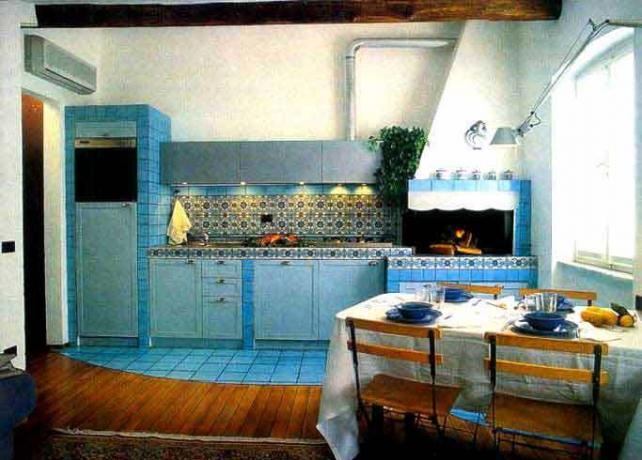
Floor zoning
The flooring is an integral part of the overall design. You can use different materials to decorate the floor, thereby drawing a clear dividing line between the kitchen and the dining room.
The solution should be interesting, practical and aesthetic. The ideal combination of materials - ceramic tiles and parquet, porcelain stoneware and engineered board.
Moreover, zones can be highlighted by combining not only different textures, but also different colors, playing in contrast. It turns out very beautifully, the room remains spacious, but visually it has a clear functional framework.
Porcelain stoneware for the kitchen floor - see here.
Podium
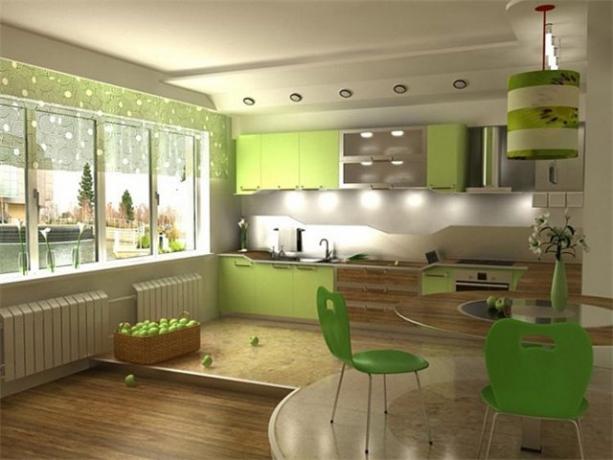
Podium in the kitchen
An ordinary step twenty centimeters high can radically change the appearance of any room. It helps to mask various engineering interchanges, significantly saves space in the room.
The most important function of the podium is clear zoning of the space. The difference in height for any of us is a visual boundary, it emphasizes the dominant object, making it stand out from the general space. Any part of the room, if it rises above another part of it, becomes very cozy and attractive.
Everything that is placed on a high step involuntarily becomes the main one, acquires a significant status. With the help of the podium, experienced designers can easily correct the geometry of the room.
For example, in an elongated space, a "stage" set between two corners brings harmony and order. The corner step gives dynamism to the combined room, but only if the ceiling height allows it to be built.
The podium is a self-contained area, so it needs additional lighting. If you put a kitchen on it, the frame option will not work.
We'll have to build a monolith, it's easy to make it yourself. There is a detailed video that allows you to analyze in detail the features of the editing technology.
Note! Monolithic podiums are made of concrete or cement-sand screed. They are durable, moisture resistant, but heavy, not every floor can withstand a massive step, so its construction must be coordinated with specialists.
There is another option for the construction of the podium - the construction of a metal or wooden frame. This option has a light weight, it has more functionality, since it is easy to organize an additional storage system in the resulting niches. But not every kitchen set can be put on such a structure.
There is always a risk of breakages in the case of improper assembly. And the price of this option will be much higher than the monolith. Therefore, experts recommend carefully choosing this zoning method.
Multilevel ceilings
You can zone the combined space with the help of multilevel ceilings. They allow you to create an original design that emphasizes the characteristics of each specific site.
In a room where there are practically no partitions, functional areas are successfully formed by additional ceiling levels. Look at the photo, they prove once again that the decorative possibilities of complex ceilings are almost endless.

Multilevel ceilings in the kitchen
For example, in the dining area, an oval that repeats the geometry of the dining table, or a complex pattern that repeats the distinctive line of the floor finish works well. Multilevel ceilings can have a wide variety of shapes.
Most often, there are classical geometry or curved, spherical shapes, combinations of a curved line and a triangle, level differences relative to the base coating.
Sometimes stucco molding, original cornice systems, just abstract design compositions are used. It makes no sense to list the existing options. There are a great many of them, and they all do an excellent job with the designated constructive task.
Other architectural elements

How to separate the kitchen area from the dining area
You can also divide the space with the help of other architectural elements.
This can be done with
- Low stationary partitions. They are easy to build from foam blocks, glass blocks, make wooden gratings or install transparent racks.
- Any space is easy to visually divide using arches, columns or through niches. The use of such techniques is often dictated by the features of the layout itself. Slender columns help create a sense of the correct architectural volume. The smooth curved line of the arch forms a chamber.
- Works great bar counter. It can be effectively played with the creation of a massive island, which from the kitchen side will become part of the technological process, and from the dining room side - an excellent design object.
- Clearly divides space and different finishing. In a spacious room, the work area is distinguished by darker colors, other wallpapers are selected, and then visually the space changes greatly. Equally decorated walls and bright decorative spots look good. Highlight the apron above the kitchen work surface, make it juicy, contrasting, interesting, it will always will attract attention and form the correct perception of a functional feature space.
Bar counter for the kitchen - see here.
Shine

Zoning with light
It is the light that helps to draw the necessary lines, helps to properly manage the combined space. The working part of the room is illuminated more intensely and more practical, the dining area, on the contrary, is easy to decorate with decorative lamps.
If you just lower a long lamp over the dining table, which will illuminate brightly only the tabletop, you can do nothing else. One such detail can replace all other techniques.
Generalization on the topic

Combined space design
There are many ways to create visual boundaries of functional areas. It can be different wallpapers on the wall, and a clear arrangement of flowers in pots on the floor, and the use of special architectural elements.
The main thing is to achieve a certain harmony, capable, despite a clear division, to make the room a single whole. You only need to hint at the autonomy of the parts, but in fact try to integrate them into each other.
There is an instruction that allows you to understand what is the meaning of such a rework. Divide zones by combining.
Maintain the set style in everything, especially in small details. It is important that the same rhythms are read in all components, then the situation will be comfortable.


